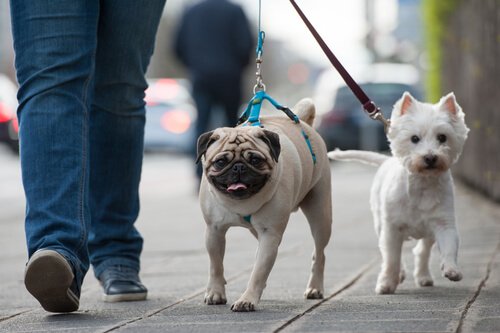Collar or harness: Which is best for your dog?

One of the first questions dog owners ask themselves when they adopt a dog is whether to go with a dog collar or harness. There are a lot of opinions out there on which is best, so first-time owners have to filter through them all to figure out what’s best for their dog.
To help your decide whether to get a collar or harness, we’ll lay out the advantages and disadvantages of each.
Collar or harness? That is the question
Lots of people choose dog harnesses because they’re trendy. But dog collars have always existed, so why veer away from the tried and true? Let’s look at each one to help you decide whether a collar or harness is best for your dog.

The collar
Many dog owners don’t think deeply about the choice between collars and harnesses. Plenty get distracted by the wide range of color options and just assume that the tried and true collar is best.
Since veterinarians don’t usually recommend collars anymore, they’ve become less popular than harnesses. Vets stay away from collars because dogs have such delicate necks.
There are muscles and bones in a dog’s neck that can get injured and cause further problems. Dogs could experience muscle spasms, neurological issues, difficulty breathing or thyroid problems if their necks are injured, which could happen if the owner pulls on their leash a lot.
Cruelly, some owners keep their dogs constantly tied up as a form of punishment, which could easily hurt their necks. It’s also not uncommon for dog owners to “train” or reprimand their dogs by pulling the leash hard. But this is abusive and unnecessary — a dog won’t understand what you want; they won’t learn anything.
Some owners mistakenly put their dogs on very short leashes, and that could hurt them if they wander off to sniff something. If your dog is sociable, a short leash and collar might prevent him from greeting other dogs. He might start to associate walking — and the collar — with negativity and not want to go out anymore.
We recommend collars only for relaxed dogs that obediently follow commands and don’t usually pull on the leash. With calm dogs, collars will just be an accessory, not a form of torture. If your dog is active and enthusiastic, don’t get him a short leash.
The harness
Now, let’s look at the benefits of harnesses. Harnesses are undoubtedly less harmful and more beneficial to dogs than collars. Because of the way they distribute force across the dog’s body, they won’t hurt their necks or backs.
When your dog gets excited and pulls towards something on a walk, a harness won’t choke him. He’ll feel restrained, so he’ll be less likely to continually pull on the leash.
Make sure the harness is made of breathable fabric. Adjust the back strap so force is distributed throughout the body and doesn’t hurt the dog’s joints or spine. The harness also shouldn’t cover a huge portion of your dog’s body.
Make sure that the harness isn’t too tight in the armpit area so that the friction of harness on skin isn’t painful. A harness should always go around the chest and never around the neck.
The harness should be an appropriate size for your dog. If the harness is big, he could escape, and if it’s too small, it could cut off his circulation.

Which is better for your dog?
There’s no doubt that dog harnesses are better than collars, as long as the harness fits. Harnesses distribute the force created by pulling on the leash throughout your dog’s body, and they’re better at preventing serious injuries than collars.
If you do get a dog collar, make sure that it has padding, is wide and comfortable to wear, and doesn’t squeeze his neck. Pick one that fits your dog’s personality and behavior!
This text is provided for informational purposes only and does not replace consultation with a professional. If in doubt, consult your specialist.